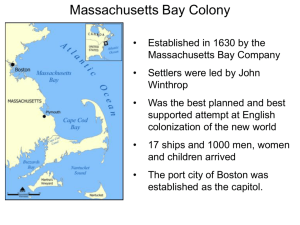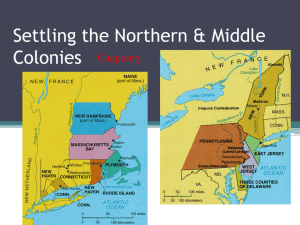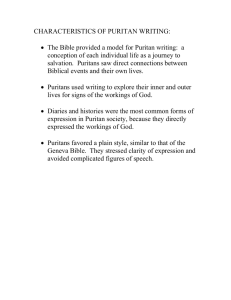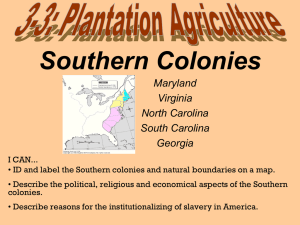Unit 1-Foundations to 1733 (`1492-1733)
advertisement
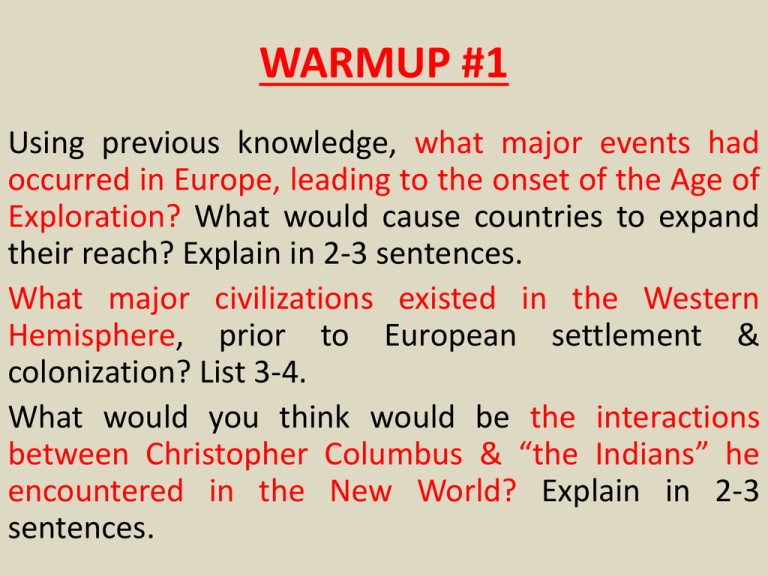
WARMUP #1 Using previous knowledge, what major events had occurred in Europe, leading to the onset of the Age of Exploration? What would cause countries to expand their reach? Explain in 2-3 sentences. What major civilizations existed in the Western Hemisphere, prior to European settlement & colonization? List 3-4. What would you think would be the interactions between Christopher Columbus & “the Indians” he encountered in the New World? Explain in 2-3 sentences. Pre-Columbian America Cahokia, at its height I. Earliest “American immigrants” A. Asians crossed the Bering Strait in several migrations beginning about 14,000 years ago B. eventually, groups spread all the way to the tip of South America C. by Christopher Columbus' arrival, several significant cultures had developed in the region south of the current United States 1) Incas in Peru: by 1438 AD, they controlled most of the Andean region. Conquered by Francisco Pizarro 2) Mayans in the Yucatan: by 300 AD, the city of Tikal featured 20,000 residents & elaborate temples 3) Olmecs in Mexico: by 500 AD, over 100,000 residents on the current site of Mexico City 4) Aztecs in Mexico: conquered by Hernan Cortes in 1520 AD Civilizations in the Americas Incan Civilization Mayan Civilization Aztec Civilization II. North American cultures A. most Native Americans developed a stone age culture (little metalwork, no written language, no use of the wheel) B. Hohokam culture (200 - 1450 AD) in southwest United States 1) extensive use of irrigation canals for crops 2) adobe buildings as tall as four stories built, probably for religious purposes 3) gradual decline & dispersal into small groups C. Hopewell culture (100 - 400 AD) in the Northeast & Midwest 1) agricultural rather than hunter-gatherers 2) large mounds for religious purposes or burials, mostly along the Ohio River D. Mississippi River cultures (900 -1500 AD) 1) mound-builders (largest city, Cahokia, had as many as 40,000 residents & was the largest city north of Mexico) 2) highly-developed trade system with Native Americans throughout North America 3) maize cultivation 4) after contact with Europeans, civilization declined & many tribes turned to nomadism III. Contact with Europeans A. Transatlantic exchange (“Columbian Exchange”) 1) Old World received food (corn, potatoes etc), syphilis, gold 2) New World received horses, smallpox, Christianity, slavery B. Most Native American groups were decimated by displacement, disease & warfare 1) Arawaks met by Christopher Columbus numbered 250,000 in 1492. By 1550, 500 survived. By 1650, 0! 2) Native Americans of North America met the Spanish in the West, the English & Dutch in the East & the French in Canada. In almost all encounters, the Native Americans were conquered or made dependent upon the Europeans The Columbian Exchange WARMUP #2 Match the European nation with the primary region of their exploration, settlement & colonization within the New World of the Americas. A. Great Britain 1. Latin America B. France 2. Brazil C. Spain 3. American colonies D. Portugal 4. New Amsterdam E. the Netherlands 5. Canada Colonial Beginnings John Winthrop: Puritan leader of Massachusetts Bay Colony I. European Models for Colonizing America A. Spain: colonization with conversion 1. earliest colonies in America (St. Augustine 1565, Santa Fe 1610), though most outposts were destroyed by Native American attacks 2. Spain turned to Franciscan missionaries to control Native Americans, placing land grants in the hands of encomenderos. Spanish rule was cruel, used slavery & was limited, except for New Mexico. California was virtually ignored until the late 1700s 3. by 1560, the main goal of Spanish colonial policy was keeping other Europeans from establishing colonies B. France: fur-trading empire 1. Native American wars developed as tribes fought for the French fur trade 2. French missionaries did not enslave Native Americans & attempted to limit trading of alcohol 3. though few in number, French settlers brought diseases that wiped out up to 90% of the Native Americans in the Great Lakes region C. Netherlands: commerce & farming 1. colonization was slow & small-scale, with only one proprietor (Kiliaen van Rensselaer) able to attract 50 tenants 2. rejecting representative rule, the Dutch lost the settlement of New Amsterdam (New York) to the British in 1664 D. Great Britain (England): tobacco & settlers 1. causes for English colonizing in North America: a. fall of the Spanish Armada in 1588 opened up North Atlantic to English expansion b. England infused with a spirit of self-confidence & enthusiasm for adventure c. England could plant, supply & protect colonies easily 2. changes in the English economy: a. rise of merchant class to provide business leadership & wealth for colonial investment b. joint-stock companies allowed for pooling of capital with limited risk c. surplus population in cities as farmers were pushed off lands converted to sheep herding 3. Protestant Reformation a. priesthood of all believers inspired religious dissidents b. anti-”Popish” believers (Puritans) felt that the Church of England was not Protestant enough in its beliefs & practices c. persecution of Puritans, Catholics & Quakers led to conflict with religious & political authorities d. North America was seen as a desirable haven for these groups II. Jamestown & Virginia A. Virginia Company received charter (guaranteeing settlers the same rights as Englishmen at home) from King James I for settlement in America (1607). Goals (the 3 G’s: God, glory, gold): 1. gold & wealth 2. convert Native Americans to Christianity 3. find a passage to the Indies B. early group suffered from laziness, starvation & malaria. Saved by the leadership of John Smith & enterprise of tobacco planter John Rolfe, who perfected methods of raising & curing tobacco 1. tobacco brought capital & workers to Virginia. Exports rose to 10 million pounds by 1660. The Virginia Company provided land, established a head-right system & courts & allowed self-government by the planters 2. problems with tobacco farming: a) chained prosperity of Virginia to one crop b) exhausted the soil c) promoted large-acreage plantations which needed large amounts of cheap labor. First indentured servants with few rights or chances to advance & then slaves with fewer rights & no chance to advance C. Bacon’s Rebellion (1676) 1. attacks on Native Americans by poor whites led to the killing of 300 whites. A defensive military strategy failed as Nathaniel Bacon attacked Native Americans & then seized control of the colony 2. Bacon died in 1676, but his followers pushed for tax cuts, voting rights for landless whites & an end to corruption 3. the planter class sought to limit the number of white servants who might rebel again, thus opening the way for slavery’s expansion D. Contributions of early Virginia: 1. provided model for further investment in America 2. first representative self-government (House of Burgesses: 1619) 3. demand for slaves (first slaves sold by Dutch to settlers in 1619) III. New England Colonies (settled most frequently by families) A. Separatists (Pilgrims) arrived at Plymouth in 1620 on Mayflower after initial settlement in Holland 1. Mayflower Compact: first document of self-government in America 2. after difficult first winter (44 out of 102 survived), Pilgrims survived under the leadership of Governor William Bradford B. Puritans established Massachusetts Bay in 1630 (John Winthrop & 900 settlers) for economic & religious reasons 1. large numbers of middle class settlers, many of whom were educated 2. successful as fur traders, fishermen & shipbuilders 3. Great Puritan Migration of 1629-1640 brought many new settlers 4. ruled as “Bible Commonwealth” with franchise restricted to male members of Puritan (later Congregational) church: probably 1/5 of adult white male population C. Puritans & Pequots: series of disastrous contacts 1. smallpox epidemic of 1633 killed over 10,000 Pequots 2. 500 Pequots killed by Puritans in 1636 3. disease, military force & religion (praying towns) essentially pacified Native Americans of New England by 1670 D. King Philip’s War or “Metacom’s Rebellion” (167578): Wampanoag leader organized neighboring tribes to attack settlements in 1675, resulting in 1,000 white & 4,500 Native American deaths WARMUP #3 From your previous knowledge, list the original 13 American colonies, subdividing them along regional lines (i.e. New England, Middle, Southern). American Colonies Penn's Treaty with the Indians by Benjamin West (Pennsylvania Academy of the Fine Arts) RELIGION GOVERNMENT ORIGINAL PURPOSE ECONOMICS COLONY FOUNDED REGION FOUNDER Roanoke * 1585 Southern Sir Walter Raleigh Virginia 1607 Southern John Smith Anglican royal trade & profits tobacco founded as jointstock company. House of Burgesses (1619). Only 60 of 1st 900 colonists survived Plymouth * 1620 New England William Bradford Puritan corporate religious freedom for Separatists mixed farming Mayflower Compact (1620). Led by William Bradford New York 1626 Middle Peter Minuit none proprietary, then royal trade & profits mixed farming, furs set up as a Dutch Colony, but taken over by English (1664) Massachusetts Bay 1630 New England John Winthrop Puritan corporate religious freedom for Puritans mixed farming, fishing, shipbuilding led by John Winthrop. 18,000 settlers by 1642 (“City on a Hill”) established English colony in the New World NOTE colonists disappeared without a trace COLONY FOUNDED REGION FOUNDER RELIGION GOVERNMENT ORIGINAL PURPOSE ECONOMICS NOTE New Hampshire 1630 New England John Mason Puritan corporate, then royal escape for those constricted by religious & economic rules mixed farming Puritan harshness led these settlers north & inland Maryland 1634 Middle George Calvert none (Anglican after 1692) proprietary religious freedom for Catholics tobacco founded by George Calvert. Slow growing (only 600 by 1650) Maryland Toleration Act (1649) Connecticut 1636 New England Thomas Hooker Puritan corporate: Fundamental Orders of Connecticut (1639) religious & economic freedom mixed farming leaders of Massachusetts Bay asked Thomas Hooker & his followers to leave Rhode Island 1636 New England Roger Williams/ Anne Hutchinson none corporate religious freedom mixed farming Roger Williams set up most tolerant colony Delaware 1638 Middle Peter Minuit none proprietary trade & profits established by Sweden, but taken by the Dutch, then the English COLONY FOUNDED REGION FOUNDER RELIGION GOVERNMENT ORIGINAL PURPOSE ECONOMICS NOTE North Carolina 1653 Southern group of proprietors Anglican proprietary trade & profits rice joint business venture New Jersey 1660 Middle Lord Berkeley none proprietary trade & profits mixed farming established by Sweden, but taken by the English (1664) South Carolina 1670 Southern group of proprietors Anglican proprietary trade & profits rice rice: major crop Pennsylvania 1682 Middle William Penn none proprietary religious freedom for Quakers; trade & profits wheat; mixed farming originally Quaker, but this colony became home to many European immigrants Georgia 1733 Southern James Oglethorpe Anglican royal debtor colony rice buffer for Spanish colonies. Originally outlawed slavery & restricted size of land grants to 500 acres WARMUP #4 Match each colonial document or event with its importance, in the establishment of an American democratic society. A. Virginia House of Burgesses (1619) 1. first written constitution B. Mayflower Compact (1620) 2. first document of self-government C. Fundamental Orders of Connecticut (1639) 3. established freedom of the press D. Maryland Toleration Act (1649) 4. first representative legislature E. Peter Zenger trial (1733-34) 5. first document for freedom of religion American Puritanism The Puritan by Augustus Saint-Gaudens (1887) Brookgreen Gardens, South Carolina I. Key Puritan Beliefs & Values A. Godly people were sober, hardworking & responsible. English society had been corrupted by foreign influences & by disorder & needed to be purified B. Catholicism had undermined the relationship between God & the individual 1. rituals & sacraments administered by a powerful & complicated hierarchy (pope, cardinals, bishops etc.) 2. insistence on Latin as the only language of religion 3. confession only through the priest & the confessional booth C. election & predestination: God chooses who is saved & who is damned. No one can earn salvation through works, yet the saints are responsible for their actions (Calvinism & “TULIP”) D. the congregation of saints chooses its members, hires & fires its ministers & recognizes no other religious authority E. worship should be plain, lack mystery & be focused on God. No stained glass, instrumental music, or art F. value of education 1. the Bible should be read by everyone. New England in the 17th century was the most literate place in the world (probably 70% literacy) 2. publicly supported schools needed to oppose Satan ("Old Deluder" laws). Each town with 50 families was required to support a teacher 3. Harvard College (Cambridge) founded in 1636 to train ministers G. intolerance: error must be opposed & driven out 1. persecution & expulsion of Anne Hutchinson (1638): a) criticized ministers for not preaching covenant of grace b) held religious meetings in her home c) challenged the political & religious leadership of Massachusetts Bay 2. Roger Williams expelled for "new & dangerous opinions" (1638) a) preached complete separation of church & state: the state should have no influence over a person's conscience b) religious groups should be supported by voluntary tithes, not taxes c) Native Americans should be paid for lands d) settled Rhode Island & established complete freedom of religion (including Jews, Catholics & Quakers) 3. Puritans persecuted & expelled Baptists (opposed to child baptism) & killed Quakers (such as Mary Dyer) for preaching "inner light" doctrines & opposing any religious authority (no ministers or sermons) II. Puritan Political Life A. freemen (adult male heads of families) ruled in church meetings & town meetings B. blurring of political & religious authority: theocracy, not democracy was the goal. John Winthrop's vision of a "City Upon a Hill” C. Halfway Covenant developed to allow un-baptized members (children of Puritans) to vote & thus preserve influence of Puritan authorities III. Salem Witchcraft Crisis (1692) A. group of girls accused fellow villagers of witchcraft B. trials (featuring "spectral evidence" & body searches for birthmarks) resulted in convictions of many & executions of 20 people & 2 dogs C. goal was restoration of the disciplined community. No confessed witches were hanged or burned D. reaction resulted in anti-Puritan sentiment, weakening of Puritan authority & apologies from some religious leaders IV. Puritan Contributions A. self-government & community responsibility 1) democracy in church rule led to democracy in town meetings 2) all community members responsible for conduct of citizens B. education critical for individual & community success C. hard work & thrift demanded of all D. high standards of moral excellence & conscience E. the family is the central element of the community WARMUP #5 Describe the rationale for replacing indentured servitude with African slavery as the means of labor in the American colonies. State the positives and negatives of this series of decisions, for not only the colonists but also the Africans subjected to slavery. Explain your answer in one clear, refined paragraph. Slavery in the American Colonies The Old Plantation Abby Aldrich Rockefeller Folk Art Center: Williamsburg, Virginia I. Slavery's Early Presence A. 1st African-Americans that arrived in Jamestown in 1619 were brought as servants, not slaves B. very small numbers of slaves in the Southern colonies in the early years. Indentured servants were cheaper & available. By 1650, only 300 blacks lived in Virginia 1. after 1660, white servants became harder to obtain as English economy improved 2. slaves became seen as a better long-term investment & were more easily recaptured C. slavery formally established by the House of Burgesses in 1670 with law declaring "all servants not being Christians imported into this colony by shipping shall be slaves for their lives” D. by 1700, there were 25,000 slaves in the American colonies & by 1750 there were 100,000 slaves in Virginia, far outnumbering indentured servants 1. breaking of the Royal African Company monopoly in 1697 opened the slave trade to competition, forcing prices down & increasing the number of slaves (Triangular Trade & “Middle Passage”) 2. in some Southern areas, slaves were beginning to outnumber whites II. Slavery, Race & Economics A. slavery, though originally adopted for economic reasons, eventually was justified by Southern whites on the basis of race 1. whites concluded that extermination of Native Americans & enslavement of Africans was logical in that whites were civilized & others were barbaric 2. language used to describe blacks & Native Americans was similar: "brutes, heathen, naked, etc." It also was how educated Englishmen described poor members of society B. legal codes gradually made racism the official policy of the colonial governments 1. it was made a crime for a slave to insult any white, regardless of position 2. slave owners were allowed to punish, maim, or even kill slaves C. informal social bargain between wealthy & poor whites sought to prevent class rebellion, which erupted in Bacon's Rebellion (1676) III. Plantation Culture A. some plantations were enormous (40,000 acres, with hundreds of slaves), but most were small, self-contained communities B. over three-fourths (75%+) of all blacks lived on plantations of at least 10 slaves; over half (50%+) lived in communities of 50 slaves or more C. family relationships 1. marriage not encouraged among slaves by owners 2. slaves attempted to construct strong families, though any member could be sold at any time 3. creation of kinship networks & surrogate "relatives" unrelated to families D. language development: Gullah (hybrid of English & African languages) allowed connection with ancestry & conversations that whites could not understand E. work patterns 1. most slaves (men & women) worked as field hands 2. house servants lived in better circumstances, but were isolated from other slaves on the plantation 3. on larger plantations, slaves learned trades & crafts: blacksmithing, carpentry, shoemaking, midwifery F. economically, plantations were often efficient & productive. Socially, they achieved stability at the cost of human freedom & dignity • • • • • • • • • • • • • • • • • • • • http://sweetgrassmarketing.net/gullahtours/wp-content/uploads/2011/06/LordsPrayer.mp3 http://sweetgrassmarketing.net/gullahtours/wp-content/uploads/2011/06/Psalm-23.mp3 Uh he'p dem: "I help them/I helped them” Uh bin he'p dem: "I helped them” Uh gwine he'p dem: "I will help them” Uh done he'p dem: "I have helped them” Uh duh he'p dem: "I am helping them” Uh binnuh he'p dem: "I was helping them” Da' big dog, 'e bite'um: "That big dog, it bit him” Duh him da' cry out so: "It is him cried out that way” Uh tell'um say da' dog fuh bite'um: "I told him said that dog would bite him” De dog run, gone, bite'um: "The dog ran, went, bit him” Da' duh big big dog: "That is a big, big dog” Uh gwine gone dey tomorruh:"I will go there tomorrow.” We blan ketch 'nuf cootuh dey: "We always catch a lot of turtles there.” Dem yent yeddy wuh oonuh say: "They did not hear what you said.“ Dem chillun binnuh nyam all we rice: "Those children were eating all our rice.” E tell'um say 'e haffuh do'um: "He told him that he had to do it.” Duh him tell we say dem duh faa'muh: "He's the one who told us that they are farmers.” De buckruh dey duh 'ood duh hunt tuckrey: "The white man is in the woods hunting turkeys.” Alltwo dem 'ooman done fuh smaa't: "Both those women are really smart.” Enty duh dem shum dey?: "Aren't they the ones who saw him there?”

